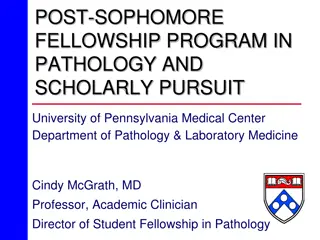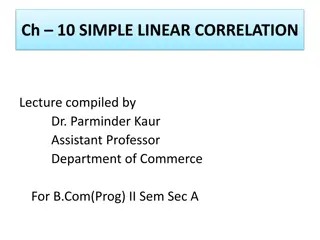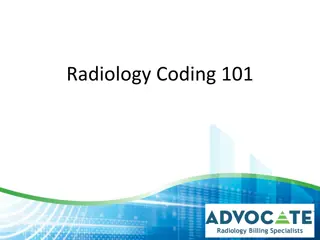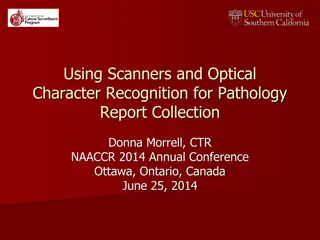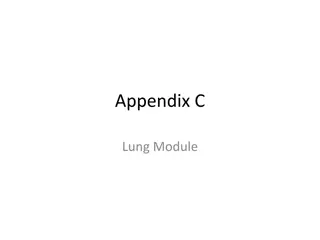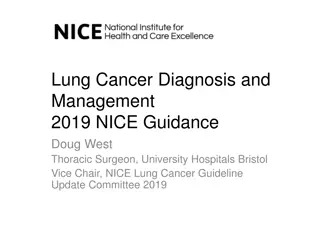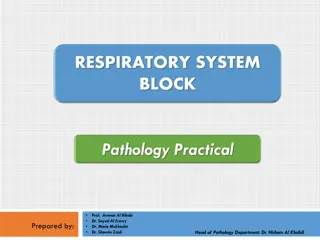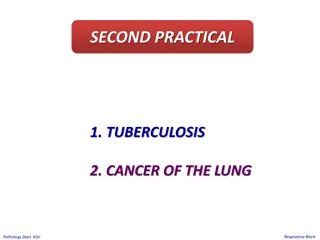Radiology-Pathology Correlation Case Presentation: Ms. DR - Lung Mass Evaluation
Ms. DR, a 62-year-old female with a history of tobacco use, presents with a right lung mass and possible metastatic disease. Imaging reveals a FDG-avid lung mass suspicious for primary malignancy. After obtaining informed consent, a CT-guided core biopsy is performed, showing cohesive, medium-sized cells consistent with squamous cell carcinoma. The final diagnosis is squamous cell carcinoma of the lung.
Download Presentation

Please find below an Image/Link to download the presentation.
The content on the website is provided AS IS for your information and personal use only. It may not be sold, licensed, or shared on other websites without obtaining consent from the author. Download presentation by click this link. If you encounter any issues during the download, it is possible that the publisher has removed the file from their server.
E N D
Presentation Transcript
Radiology Pathology Correlation Case Presentation Thuy Ho, MS4 October 6, 2017
Patient: Ms. DR is a 62 yoF with history of tobacco use Initial presentation at outside ED Chest discomfort with deep respiration Negative for hemoptysis or sputum production Imaging work-up in the ED Right lung mass, with possible mediastinal/hilar metastatic disease seen on CT chest Past Medical History DM, HTN, HLD Coronary artery disease s/p MI and stents x2, on ASA & Plavix COPD/ chronic respiratory failure on home O2 since Nov. 2016 Atrial fibrillation (not on anti-coagulation) Social History Smoked for 42 years; quit 6 years ago. No EtOH use
Imaging Whole Body CT 9/6/17 RLL subpleural 4.9 cm x 3.9 cm mass (previously 3.4 x 2.9 cm on June 11, 2017)
Imaging Perihilar solid nodule adjacent to the aforementioned mass, concerning for contiguous metastatic focus
Imaging PET CT Right lower lobe FDG avid lung mass, increased in size from the prior, highly suspicious for primary malignancy. No evidence of suspicious mediastinal or hilar adenopathy.
Pre-Procedure Informed consent obtained Labs: INR 0.9 Platelets 122 Hb 11.8/ HCT 27.2 Patient had panic attack right before biopsy; evaluated by attending Received conscious sedation; became calm Confirmed her wish to proceed with lung biopsy
Biopsy 9/25/17 CT-guided core biopsy with FNA of RLL subpleural mass Posterolateral approach Patient on left side FNA x 1, 22-gauge Core x 5, 18-gauge Post-Procedure: pt monitored for 1 hr, no complications
FNA Results Cohesive, medium-sized cells Arranged in clusters Abundant cytoplasm, eosinophilic Moderate pleomorphism Coarse, hyperchromatic nuclei Related image
Core Biopsy Results Image result for squamous cell carcinoma lung core biopsy Nests of cells Intercellular bridges Keratinization Final diagnosis: squamous cell carcinoma No additional staining needed for diagnosis
Immunohistochemistry PD-L1 Image result for squamous cell carcinoma lung PDL1 immunohistochemistry Cytoplasmic Strong positivity (3+/3) in approximately 100% of tumor cells
PD-L1 Programmed cell death ligand-1 Expressed by tumor cells, interacts w/ PD-1 on T cells, triggers CTLA-4 pathway Leads to suppression of anti-tumor T-cell response Tumor escapes immune surveillance
Squamous Cell Carcinoma High correlation with smoking history; more common in men Gross pathology: Tend to arise centrally in major bronchi, eventually spread to local hilar nodes; may be peripheral! Predominant in peripheral: emphysema, interstitial fibrosis, entrapped pneumocytes inside tumor Large lesions may undergo central necrosis, leading to cavitation Symptomatic stage: mass obstructs lumen of major bronchus distal atelectasis & infection; lesion also invades surrounding lung parenchyma Extra-thoracic dissemination takes longer than other histologic types do Histologically, ranges from well-differentiated (keratin pearls, intercellular bridges) to poorly differentiated
Squamous Cell Carcinoma TNM Staging Our patient: Tumor: 4.9 cm in greatest dimension = T2b Nodes: N0 Metastases: M0 At least Stage IIa Treatment: Surgical resection is standard treatment for Stage I & II in surgical candidates Adjuvant chemotherapy indicated for Stage II disease E.g. Platinum-based (cisplatin)
Squamous Cell Carcinoma New, promising treatments: Immunotherapy (e.g. anti-PD-L1 & anti-PD1) Most clinical trials so far study response in advanced disease, post platinum-based therapy
Case Follow-Up Followed by UVA Pulmonology In contact with Emily Couric Cancer Center Referred to Cardiothoracic Surgery on 9/28/17
Thank you! References Zusman-Harach SB, Harach HR, Gibbs AR. Cytologic features of non-small cell carcinomas of the lung in fine needle aspirates. J Clin Pathol. 1999 June;44:997- 1002. Nandeesh BN, Crasta J, Tirumalae R. Fine-needle aspiration cytology in the diagnosis and typing of lung carcinomas. Clin Cancer Invest J. 2015 Sep;4(5):637- 644. Travis WD, Brambilla E, Noguchi M, et al. Diagnosis of Lung Cancer in Small Biopsies and Cytology: Implications of the 2011 International Association for the Study of Lung Cancer/American Thoracic Society/European Respiratory Society Classification. Arch Pathol Lab Med. 2013 May; 137(5): 668 684. Derman BA, Mileham KF, et al. Treatment of advanced squamous cell carcinoma of the lung: a review. Transl Lung Cancer Res. 2015 Oct; 4(5): 524 532. Leprieur EG, Dumenil C, et al. Immunotherapy revolutionises non-small-cell lung cancer therapy: Results, perspectives and new challenges. Eur J Cancer. 2017 Jun;78:16-23. Hayashi T1, Sano H, Egashira R, et al. Difference of morphology and immunophenotype between central and peripheral squamous cell carcinomas of the lung. Biomed Res Int. 2013;2013. West HJ, Vallieres E, et al. Management of stage I and stage II non-small cell lung cancer. UpToDate. Updated Sep 15, 2017. Questions?







